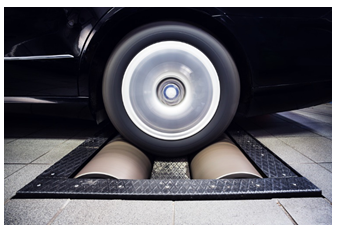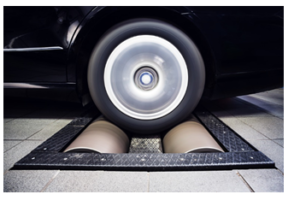The EPA’s Fuel Efficiency Testing May Not Work. Like, at All
In 2012 President Obama instituted new, aggressive fuel economy standards for automakers selling cars in the United States. The executive branch—represented here by the Environmental Protection Agency, basically—mandated that every car manufacturer would have to have a fleetwide average gas mileage of 54.5 miles per gallon by 2025.
The Corporate Average Fuel Economy standards (CAFE to transit nerds) take the gas mileage of every car a company sells—from Yaris to Tundra, Verano to Enclave, Golf to whatever—and average it out. You want to build a gas-guzzling, smoke-pumping, V-18 for hauling a camper dragging a boat? You’re gonna need to sell a hybrid, too.
Yesterday, a technical assessment report from the EPA, National Highway Traffic Administration, and the California Air Resources Board took a look at those standards and said, yeah, car companies should be able to hit them. The technology is there, or will be.
But there’s a problem: Even if the car companies do, they don’t. Or at least, no one has any way to know if they do. Because the EPA’s test to make sure automakers are hitting their CAFE numbers—the sole federal, legal requirement that cars get more efficient—probably doesn’t work. At all.
“The test is fucked up big time,” says Dan Becker, director of the Safe Climate Campaign. “It’s akin to telling all parents that their kids are getting A’s on the exam, when they’re not.”
Flawed Testing
CAFE dates back to 1975, just half a decade after the Clean Air Act established the Environmental Protection Agency. To figure out if companies were adhering to the new rules, EPA started running cars through the emissions tests it had on hand—basically putting the car on a dynamometer, a kind of treadmill, and monitoring the results. Instead of just looking at tailpipe emissions for things like nitrogen oxide and carbon dioxide, the agency started checking gas mileage, too. In 1977, consumers started seeing the results on window stickers when they were shopping for cars.
But the standards for testing, the so-called city and highway drive cycles, were as 1970s as a pair of plaid bell-bottoms. They assumed you drive 48 mph on the highway and never hit stop and go traffic, use the air conditioner, or drive when it’s colder than 68 degrees. The maximum rate of acceleration would take you from 0 to 60 mph—if you ever did such a thing—in about 20 seconds. The EPA drove like your grandfather.
That made for aggravatingly optimistic fuel economy numbers, so the EPA added new drive cycles to take into account higher speeds, winter driving, and AC use. And by 2008, the standards were better; a 2013 Consumer Reports study tested more than 300 cars, and found 90 percent landed within two miles per gallon of their EPA-approved ratings.
The updated cycles still have trouble evaluating newer technology: Hybrids and cars with turbocharged engines tend to do way better in the lab than on the road. And the software in today’s cars give automakers more control over how vehicles perform, so they could be programming the cars to do well on the dynamometer, regardless of what that means for real-world fuel economy. Still, it’s better than nothing.
Room for Improvement
Except it isn’t. The mileage reported on those window stickers? Probably fine. But when it comes to CAFE, the system is bonkers. When the EPA tests for CAFE compliance, it still uses that laughable two-cycle system. It’s got no choice: The 1975 Energy Policy and Conservation Act specifies that “the Administrator shall use the same procedures for passenger automobiles the Administrator used for model year 1975.” In other words: When it comes to enforcing the only law the demands cars get better for consumers’ wallets and lungs, the EPA tests like your grandfather.
The EPA is comfortable with the testing regimen, says a senior engineer who asked not to be named, per agency policy. If you’re worried about greenhouse gases and fuel economy, he says, the tests work. “We have complete confidence there’s direct evidence that those standards are giving us real world GHG emission reductions and fuel consumption savings.”
Even if you wanted to fix the rules to update CAFE testing, you probably couldn’t. Congress would have to approve changes to the process, and even if the governing body was in a regulatory mood, advocates for heightened tests might not want to bring it up. “Anytime you say, ‘Okay, let’s rewrite this law,’ then anything can happen,” says David Greene, a University of Tennessee Knoxville researcher who specializes in fuel economy. A Republican congress and regulation-averse industry could gut the law altogether.
Meanwhile, the EPA doesn’t know exactly how its CAFE testing correlates with actual results, because it has never done a comprehensive study of real-world fuel economy. Nor does anyone else. The best available data comes from consumers who report it to the DOT—hardly a scientific sampling.
Again, the EPA engineer I talked to said he didn’t think it was a problem. The agency looks at thousands of “real world activity profiles” to monitor the differences between the test conditions and how people actually drive. But not everyone thinks it’s enough.
“Since CAFE testing is done using the two-cycle system, it’s likely automakers are prioritizing technologies that do well in those conditions, without considering how they do in the real world,” says John German, a researcher with the International Council on Clean Transportation and one of the people who exposed the Volkswagen diesel scandal.
In other words, today’s CAFE testing regimen encourages automakers to build cars that would be great for a world that’s flat like Kansas, temperate like San Diego, and slow-moving like the Shire. A world that doesn’t exist
https://www.wired.com/2016/07/epa-testing-broken-heres-fix/





